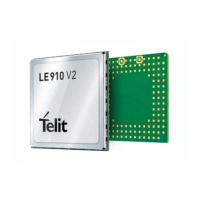Telit LE910 V2 Series AT Commands
80446ST10707A Rev. 0– 2015-11-03
Reproduction forbidden without Telit Communications S.p.A. written authorization - All Rights Reserved page 369 of 509
Mod. 0808 2011-07 Rev.2
5 - TLS_RSA_WITH_AES_256_CBC_SHA
Note: when o value is chosen, cipher suites supported
are indicated to the server within TLS handshake
(i.e.: client hello) as follows:
TLS_RSA_WITH_AES_256_CBC_SHA
TLS_RSA_WITH_AES_128_CBC_SHA
TLS_RSA_WITH_RC4_128_SHA
TLS_RSA_WITH_RC4_128_MD5
Note: TLS_RSA_WITH_NULL_SHA is not included as default(0),
but it is possible to set it(4) if required.
<auth_mode>
0 – SSL Verify None[default]
1 – Manage server authentication
2 – Manage server and client authentication if requested by the remote server
<cert_format> is an optional parameter. It selects the format of the certificate
to be stored via #SSLSECDATA command
0 - DER format
1 - PEM format[default]
Note - it is supposed that the module is just powered on and the
AT#SSLSECCFG command is entered without <cert_format> parameter, the
default format is PEM. In this case the AT#SSLSECCFG? read command
doesn’t return the setting of the format in order to meet retro compatibility with
other families. Now, let’s assume that AT#SSLSECCFG command is entered
again, but using the <cert_format> parameter for the first time: if the read
command is entered, it reports the parameter value just used. If subsequently
the <cert_format> is omitted, the AT#SSLSECCFG? read command reports
the parameter value entered the last time.
Note: Server CAcertificate has to be stored through AT#SSLSECDATA.
Note: if secure socket is not enabled using #SSLEN only test requests can be
made. Read command can be issued if at least a <SSId> is enabled.
Note: these values are automatically saved in NVM.
Read command reports the currently selected parameters in the format:
#SSLSECCFG: <SSId1>,<CipherSuite>,<auth_mode>[,<cert_format>]
Test command returns the range of supported values for all the parameters.

